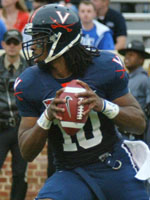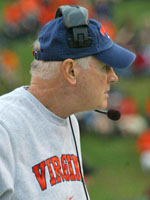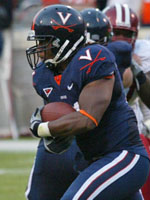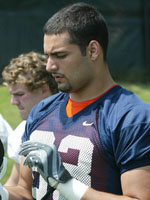 |
|
Jameel Sewell quarterbacked the Cavaliers to nine wins in 2007, including a 48-0 win in their last win against Miami. |
Times are bleak for the Virginia football program. A second consecutive loss – both this season and to Duke – bring the Cavaliers to 3-5 with some of the most difficult teams on their schedule still to come. The offense netted 196 yards, the fourth total of 201 yards or fewer this season. In back-to-back weeks, the Cavalier defense has had trouble stopping both a running team and a passing team. Special teams have been shaky at best all season, and continue to be in flux personnel-wise.
As Virginia heads to Miami this Saturday, what better time than now to recall the Cavaliers’ 48-0 throttling of the Hurricanes in the final game of the Orange Bowl two seasons ago? That game was in the midst of the last happy season for Wahoos. It was the season when Al Groh won ACC Coach of the Year and was praised for his ability to win games. It was the last year when the Cavs made a bowl – the Gator Bowl, no less. And the blowout win over Miami was one of the most captivating moments of a thrilling year for Virginia and its fans.
“You know, it wasn’t just the last game in the Orange Bowl, but it was quite the big ‘dog and pony show,'” Virginia coach Al Groh said. “All the big guns were being brought in to make this quite a celebration, and that particular [Virginia] team really took that challenge and played about as well as we could possibly play, as well as we’ve ever played against a really quality opponent.”
The Cavaliers will have to have a similarly stellar outing this Saturday in their first trip to Miami since that 2007 game, this time at Land Shark Stadium. Miami is speedy and athletic on both sides of the ball, and has one of the most explosive quarterbacks in the conference in Jacory Harris. Moreover, the Canes are already bowl-eligible with six wins, while the Hoos are only halfway there, and can afford only one more loss in their four remaining games against four teams with winning records. But, Virginia remains adamant that its about one team, one Saturday at a time.
“When you look at the big picture, yeah, it might seem difficult,” long snapper Danny Aiken said. “But we take it one game at a time, and we still have a chance to take a lead in the ACC and go to a bowl game.”
A Couple Plays Difference
Groh is never shy of making an analogy, and he had several to describe the Miami team that Virginia plays this weekend. For example, the Hurricanes come off a 28-27 win in which they scored the final 14 points; though the final score was closer than Virginia’s game with Duke, Groh said the two endings were not all that different, in that they were caused by just a few key plays that can be similarly categorized.
“It was a game that Wake Forest had the ball and an opportunity to run the clock out and were not able to do that,” Groh said, “turned the ball over to Miami in which they had a 3rd-and-10 and 4th-and-15, and Harris, the phrase that I think I used once before is, he made the kind of throws that quarterbacks who elevate their team to a different level make.”
 |
|
Virginia coach Al Groh lauded Duke QB Thaddeus Lewis and Miami QB Jacory Harris for key throws they made to lead their teams to wins last Saturday. |
Groh referred to a similar throw that Duke quarterback Thaddeus Lewis made against Virginia: the 42-yard strike across the middle of the field for the Devils’ go-ahead touchdown in the fourth quarter. Groh reiterated a point that he made in his postgame presser – namely, that the game came down to just a play here or a play there – and said the play by Lewis was a big one, and easily could have gone the other way.
“Had he missed the throw, it would have been, I’m sure, disappointing to people on their side,” Groh said, “but understandable too, because under those circumstances that throw gets missed a lot. He made the type of throw that elevates a team.”
On the other hand, Virginia has certainly been the beneficiary of plays whose outcome could have been reversed, as well – and perhaps never more so in a season than during the 2007 campaign. Groh again spoke of his mantra of “you are what you are,” and referred to both the records of his nine-win 2007 squad and this season’s team.
“Look, if you win, you win; you are what you are,” Groh said. “That doesn’t make you the worst nine-win team because the games are close; you’re a good team because it’s hard to win a game. You win nine games, you’re pretty good, and if you lose those same games it doesn’t make you that much different than the other team, it’s just a play here and there, but that’s what it is. You’ve got to find a way to make those plays.”
Another problem of late, Groh noted, is that the defense has seen too many plays – 80 against Duke, 79 against Georgia Tech. One reporter noted that the only quarter Virginia is losing is the fourth quarter, and Groh admitted that the high play-count on defense makes that statistic worthy of consideration. He added, though, that the defense being on the field too long is not exactly a quick fix – it’s a function of everything else.
“That’s a point in the game where defensively the play count has gotten to a high number,” Groh said. “That being said, you can’t attribute that fact to any one particular issue.”
Searching for an Identity
 |
|
Rashawn Jackson rushed 16 times for 84 yards against Duke. |
What is the identity of the Virginia offense? Cavalier tailbacks have combined for as many as 35 carries in a game against Indiana and as few as seven against Georgia Tech. Quarterback Jameel Sewell has been a scrambler and he has been a pocket passer. Virginia runs the spread and it runs pro-style sets. All in all, it’s hard to put a finger on what Virginia “does” offensively.
“I think when you can have [an identity], it’s a very beneficial thing,” Groh said. “Most teams work to have that. Georgia Tech’s got an identity; singular as it is, they’ve got an identity. Duke has got an identity 0 singular as that is.”
Groh went on to discuss Virginia teams in the past that had well-defined offenses.
“With Matt Schaub, Heath Miller – on offense, it was pretty clear what our identity was. We were passing the ball,” Groh said. “When we had that offensive line with Butler and Ferguson and Brown, and we had Lundy and Pearman running the ball, it was clear our identity was power running.”
An offensive identity, of course, has to do with both the coaching philosophy and the players at the coaches’ disposal. As Groh does frequently, he made analogies to other sports – a baseball team that hits home runs, or a basketball team that is run-and-gun. The most important aspect of the identity, he said, is the capabilities of the players.
“What players can do best have a great deal to do with the establishment of an identity,” Groh said. “To try to force an identity on an offense or defense without the skills match it go would be foolhardy.”
A related, oft-asked question of Groh is why Virginia has a tendency to go away from the running attack when it doesn’t work initially, despite just giving the tailbacks only a small number of carries. When asked Monday about what “sample size” he needs to know if a running game is working or not, though, Groh’s answer was more humorous than substantive, as he reflected on his statistical ineptitude – he flunked statistics twice in college.
“All I remember about sample size was that it’s got to be a certain number to make it a reasonable sample,” Groh said. “Outside of that I couldn’t figure out too many of those sample sizes, so I would have to say in my case it would have to be done visually or intuitively without any particular mathematical formula. Another one of my mental weaknesses.”
As to whether Virginia gives carries to Mikell Simpson or Rashawn Jackson , Groh said it is a simple question of who has the hot hand. Against Duke, Jackson was the more effective runner early, which is why Simpson received just two second-half carries, while Jackson received 10.
“A few of those [tailbacks] provides depth, it provides competition, it provides the opportunity to play the hotter hand if that’s necessary, and that was somewhat the case [against Duke],” Groh said. “Obviously Rashawn had a very effective first half, and it just didn’t seem to add up to make much sense to doing anything significantly different from that point on. We’ll see how the week goes, different games call for a little bit different tactics and that changes certain players’ roles at certain times, too.”
Of course, it has been the case that neither tailback has seen frequent carries, and it falls on Sewell to move the chains. With this Virginia team, it’s hard to know how they will go about picking up yards; Groh was asked if this unpredictability was a plus.
“I guess you can look at it that way,” Groh said.
Expanding Roles
 |
|
Joe Torchia had three catches for 44 yards against Duke, including his first career touchdown reception. |
Though Virginia has fallen the last two weeks, several players saw new or expanded roles – like tight end Joe Torchia , who caught three passes for 44 yards against Duke. Two of them were on back-to-back snaps, and they were perhaps the two most vital offensive plays of the day for Virginia. The first was a 19-yard reception on a play-action bootleg on 4th-and-1; the next was a 21-yard reception for a touchdown, both Torchia’s longest career reception and his first career TD.
“The [touchdown catch] probably was as good a catch as he’s had here,” Groh said. “His confidence level, as he generates it himself, perhaps hasn’t been as great as it should be. He had, besides the catches, some good blocks at the point of attack the other day, so hopefully this will be the case where this gives him the type of boost where he can really take off with his play.”
Meanwhile, corner Chase Minnifield , whose career has been detailed previously on The Sabre, appeared on many more snaps than usual last Saturday as Virginia featured a mix of sub-defense packages against Duke’s passing attack. Groh pointed out that while Minnifield saw more snaps, it was still as a slot corner on Virginia’s sub packages, a position that Minnifield has embraced from the start of the season.
“He’s really taken a real interest in that position,” Groh said. “It’s an entirely different position than playing outside corner, so when a guy goes in at that role he’s got to have the flexibility skill-wise and the mentality and the willingness to do it to learn two positions at the same time.”
Minnifield also made perhaps the most athletic play by a Virginia player Saturday, an interception in the back of the end zone that could have sealed the game for the Hoos if they had eaten up clock on their subsequent possession.
“It was a great intuitive play – just had a sense of where the ball was going, and broke on it,” Groh said. “He’s got that type of high-level athletic ability.”
Groh also discussed the sudden emergence of John-Kevin Dolce , whose career has also been discussed previously. With defensive end Matt Conrath suffering from an ankle injury the last two weeks, Dolce has started each of the last two weeks – both largely as schematic reactions to the opposing offense. Dolce saw time primarily in sub packages last year as a tackle, but has seen time in both the base defense and sub packages the last two weeks.
“We’re just trying to find a right fit for it and eliminate aspects of playing the game that might be holding him back,” Groh said. “So we were able to initially just create a role for him on the sub, and from that he tended to grow more comfortable with being in the interior, whether it was on the sub or in the regular down. And now that he’s more familiar with the schemes, it’s grown so that he’s able to take on a few more diverse roles, too.”
Though small for a traditional D-Lineman – Dolce is listed at 245 pounds – Groh said that he likely won’t put on much more weight. Groh has said that he is fine with Dolce’s weight, because he wants him to keep his quickness and athleticism as a pass rusher. Those qualities combined with his unusual strength, Groh said, makes up for any lack of size.
“He’s probably about maxed out at what he’s going to [weigh],” Groh said. “I don’t know what he is today, but I know when he came back at training camp, he was at 254, something like that. In other words, maybe he’s not a real tall person, but there is a lot of muscle on that body, a lot more than most bodies.”
Worth Noting
- Groh said that Jameel Sewell ‘s ankle sprain is still healing, but that he had an “easier week” leading up to the Duke game because there was no “dramatic flare-up” in the previous game against Georgia Tech.
- Matt Conrath ‘s healing process for his ankle injury has been slower. Groh said the slow healing is due to Conrath’s injury being new, whereas Sewell aggravated an old ankle sprain. Both players injured their right ankles against Maryland.
- After playing his 13th and 14th true freshmen against Duke – Connor McCartin and Paul Freedman – Groh said that no other true freshmen are on the verge of seeing their first action.
- This is not Virginia’s first game against Miami at Land Shark Stadium (formerly Joe Robbie Stadium/Pro Player Stadium) – the Cavs fell to the Canes 31-21 in that stadium in the 1996 Carquest Bowl. The 44 starters in that game included 20 NFL Draft picks (11 Virginia, 9 Miami).
- The Cavaliers have played three bowl games at what is now Land Shark Stadium: the 1994 and 1996 Carquest Bowl, and the 1999 Micronpc.com Bowl, all of which were losses.
- Virginia’s 48-0 win over the Hurricanes in 2007 was its first victory in the state of Florida.
Worth Quoting
“I don’t have anything to say. (Pause.) I know a lot more about the situation than probably anybody. Maybe someday I’ll say what that is.” – Al Groh Sunday on what he makes of fans who say that he should lose his job.
“It’s very unfortunate. Regardless of the result, it’s [the fans’] team, it’s their players. They’re not perfect, but they’re really good kids, and they’re trying to do the right thing, and they’re trying to play as hard as they can. It’s just unfortunate that they get that type of response. I feel badly for the players. I’d just say it’s as much a commentary on the booers as it is on the players.” – Al Groh Sunday on fans who booed him and the players into the locker room last Saturday.
“I feel like that word, those rumors, have been flying around for quite a while. They were flying around my first year. At first, maybe [it affected us], but now you don’t think much of them, because you’re so unified as a team, and brought together so much, you learn to block it out, and that’s not really any type of importance to us. I would say, no, that hasn’t really changed or affected us in any way.” – Danny Aiken on how talk of fans wanting Al Groh fired have affected the players.
“There are some times where maybe the best course of action is to bite my tongue. There are some times where it would seem that the obvious was being missed. That’s what you’re supposed to do when you coach. If you’re afraid to bring things up to players because you think it might hurt their feelings, then you’re not doing their job. You’re supposed to coach the players on everything that happens every day, and hopefully the players take the instruction to improve themselves. There were some ways that that technique could have been played differently that very likely would have resulted in a different outcome. I’m sure we’ll be in coverages that will call for that technique again here during the month of November, so hopefully when it comes up again, it will be played in a different fashion with a different result.” – Al Groh on what he will say to corner Chris Cook after he was beat for Duke’s go-ahead touchdown in the fourth quarter on a 42-yard pass from Thaddeus Lewis to Conner Vernon.



